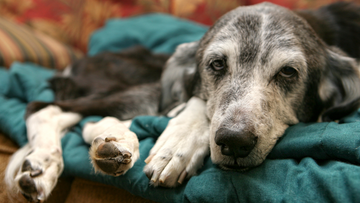Cushing’s disease, or hyperadrenocorticism, is a fairly common disease that occurs naturally and is pituitary—or adrenal-dependent. Spayed or altered dogs tend to be more prone to pituitary disorders. Pituitary-dependent Cushing’s is triggered by a tumor on the pituitary, resulting in an overproduction of adrenocorticotropic hormone and cortisol throughout the body.
Cushing’s disease is most common among middle-aged and senior dogs. Symptoms of this disease include:
- Increased thirst and urination
- Increased appetite
- Excessive panting
- Hair loss
- Lethargy
- Recurrent infections
- Enlargement of the abdomen
Traditional Treatment for Cushing’s
 Cushing’s is a life-long disease, meaning the symptoms can be managed, but it will never “go away.” Most dogs diagnosed with Cushing’s are prescribed either Trilostane or Mitotane. These medications block receptor sites to decrease the amount of cortisol produced. Selegiline hydrochloride and Ketoconazole are also sometimes used but are not considered as effective.
Cushing’s is a life-long disease, meaning the symptoms can be managed, but it will never “go away.” Most dogs diagnosed with Cushing’s are prescribed either Trilostane or Mitotane. These medications block receptor sites to decrease the amount of cortisol produced. Selegiline hydrochloride and Ketoconazole are also sometimes used but are not considered as effective.
Unfortunately, some of these medications can have side effects, including vomiting, diarrhea, and weakness.
Natural Treatment Options for Cushing’s
Glandular therapy can be beneficial for dogs with Cushing’s disease. This treatment includes supplements made from healthy animals' glands, organs, and tissues and administered in a capsule or powder. The idea behind this is that healthy tissues will help repair the corresponding tissue in the dog.
Stress Reduction
Cortisol is a stress hormone. Reducing stress mentally and physically can help lower cortisol and associated symptoms. Daily exercise can help reduce stress and promote the release of endorphins. Taking your dog for a short walk or playing with them in the backyard is a great way to achieve both goals. You should also avoid activities and products affecting your dog’s adrenal glands and liver. Many household cleaners are endocrine disruptors and can directly impact the adrenal glands. Ask your vet about the best heartworm, flea, and tick preventative for your dog.
Nutrition
Good nutrition is essential for Cushing’s disease. Natural food options do not contain excessive starch or sodium, which can exacerbate the symptoms. Read the food labels and check for overly processed ingredients and sugars. Sugars or glucose need insulin to process, which is connected with cortisol production. A good quality probiotic can also improve the gut-biome, reducing enlarged abdomens and helping them process nutrients. Fish oil can be used as a food topper. Omega 3-6-9 can lower circulating triglycerides, improve dry skin, and reduce inflammation.
Acupuncture
Acupuncture has proven to benefit a dog’s overall health. An animal acupuncturist can target specific points to help the adrenal glands and liver function. If you have a senior pet, acupuncture can also be beneficial in pain management and treating arthritis symptoms.
Working with Your Veterinarian
Cushing’s disease is complicated, and an exclusively natural option might not suit every dog. Work closely with your veterinarian when creating a treatment plan for your dog. Natural options, including nutrition, supplements, alternative therapies, and reducing stress, can be combined with traditional treatment options to keep your dog more comfortable and reduce symptoms.






















